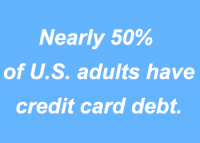Compare Personal Loans
Shop and Compare
Plastic Power Play: Getting a Grip on Credit Card Debt
According to a recent study by CreditCards.com, too many Americans are still feeling the pressure of high credit card debt.
This from the study:
- 47% of Americans carried credit card debt in mid-2020.
- Almost one-quarter (23%) of card holders went deeper in debt via their credit balance as a direct result of the Covid-19 pandemic.
- Up to 40% of Americans are unable to pay more than the minimum on their credit card bills. Higher credit card debt seems to be higher with low- and-middle income Americans, who were more likely than white-collar career professionals to lose their jobs and also be more negatively impacted by government shutdowns due to COVID-19.
Unfortunately, one year later over half (51%) of credit card debtors have added to their debt since March 2020, according to an updated CreditCards.com survey.
“That’s the K-shaped recovery in a nutshell,” said Ted Rossman, senior credit card analyst at CreditCards.com. “Some people’s finances are in better shape, while many others are really struggling. If you’re still working, maybe you’ve able to use your stimulus payments to pay down debt and you’ve taken advantage of the fact that you’ve been spending less. But if you lost your job, you might be fighting just to stay afloat.”
Fighting Back: a Five-Step Plan to Curb Credit Card Debt
Being overly burdened by credit debt stress is a problem on many levels, and it won’t get any better by ignoring the problem. On the upside, tackling the issue of onerous credit card debt can not only get you out of credit card debt, it can lead to more cash in your bank account, a higher credit score, and more restful nights.
Here’s a five-step process to cut that plastic debt down to size – once and for all:
Step #1. Make a list. Start by making a list of exactly what you owe, to whom, and at what interest rate. Then, ask all of your card issuers for lower rates.
“Nothing ventured, nothing gained – and there’s a good chance you can get modest reductions,” Rossman said. “According to Bankrate.com found 78% of cardholders who asked for a lower interest rate got one in 2020. You can probably trim a few percentage points off by asking nicely, but you still have work to do.”
Step #2. Start snowballing. Once you’ve made your list, you can start paying down debt, within your financial means, with either the highest interest rates (the avalanche method) or via the smallest dollar credit card payoff amounts (the snowball method).
RELATED: Credit Card Debt – Snowball Versus Debt Avalanche Payment Models
Rossman prefers the snowball method. “A big portion of the debt payoff is psychological, so it’s good to build momentum, but the avalanche makes the most sense mathematically,” he said. “Either way, figure out what works for you and be aggressive about finding extra money to put towards your debts (via a side hustle, selling stuff you don’t need, and cutting expenses, among other methods.”
Simultaneously, make minimum payments on all of your other debts while focusing extra funds on either the highest interest rate or the smallest balance. “Once that’s gone, move on to the next,” Rossman said. “Keep it rolling.”
RELATED: The Fastest Ways to Pay Off $50,000 in Debt
Step #3. Save at the same time. While it might seem counterintuitive to save cash when you’re trying to pay down debt, there’s a good reason for the practice.
“A savings account is the best defense against racking up high interest debt back to your cards while you’re trying to pay them off,” said Andrea Woroch, a personal finance expert at Andreaworoch.com. “That’s because your savings can cover any unexpected bills or emergencies. So save while you pay down debt.”
RELATED: How to Cut Your Credit Card Debt by 50%
Step #4. Transfer your balance. Transferring your current card balance to a new card offering 0% interest on balance transfers can help you get out of debt faster for less. “That’s because your monthly payment will go toward just your debt instead of any going toward interest,” said Woroch.
RELATED: How Does a Zero Balance Credit Card Transfer Work
Step #5. Consolidate multiple credit card debt into a single payment. Personal loans, refinancing, or debt consolidation can all work in your favor in certain credit card repayment circumstances.
“Assuming you have a credit score good enough to lower your average rate, this is a smart money decision,” said Forrest McCall, owner of the personal finance blog Don’t Work Another Day.
RELATED: Debt Consolidation Strategies
The Last Word on Curbing Credit Card Debt
One of the largest problems with having high debt attached to interest payments is that it’s dynamic, and will grow over time unless you take action.
“Your debt is never stagnant, you are either paying it down or it is growing further, so you must take action,” said Josh Richner, director of operations at FaithWorks Financial in Boynton Beach, Fla. ”Educate yourself. Create a budget. Make the uncomfortable calls to your creditors to request direct relief from them, or get help from a person or organization you can trust.”
RELATED:
What to know about personal loans and to use them for paying off debt and more.How to Use Personal Loans


Brian O'Connell has been a finance writer at TheStreet, TheBalance, LendingTree, CBS, CNBC, WSJ, US News and others, where he shares his expertise in personal finance, credit and debt. A published author and former trader, his byline has appeared in dozens of top-tier national publications.





